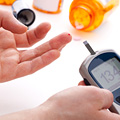(Home Blood Glucose Monitoring, Blood Glucose Monitoring, Blood Sugar Testing, Blood Sugar Monitoring)

A glucose blood test can be done at home using a glucometer.
Blood glucose testing allows people with diabetes to measure their blood glucose (sugar) levels at various times throughout the day to make sure they are within their target range.
Staying in the target range helps avoid health problems related to low blood sugar (which can cause shakiness, dizziness, and even unconsciousness or death) and high blood sugar (which over the long term can lead to kidney, heart, eye, and nerve damage).
Blood glucose testing is done using a blood glucose meter, which is a small portable machine that can be used at home or taken with you wherever you go.
The frequency of testing depends on the type of diabetes you have and the type of medication therapy you are on. Talk to your doctor about how often you should test.
Risks and precautionsThere aren't many risks to be worried about regarding blood glucose testing. You should always wash your hands with soap and water before pricking your skin to avoid infection. You can also prevent infection by never using a lancet more than once.
To avoid developing hard spots on your fingertips from frequent testing, try to use a different finger or different pricking site each time. The prick may hurt a little but you can minimize this by pricking the side of your finger, not the tip. Some blood glucose meters also allow you to test on sites other than your fingers, such as your palm or forearm.
During the test
- If the test strips come in a bottle, remove one and then put the lid back on. If the strips are stored in your meter, read the instructions on how to release one strip.
- Prepare the blood glucose meter with the test strip according to the instructions.
- Use the lancet device to prick the side of your fingertip with a lancet.
- Place a drop of blood onto the correct part of the test strip. The strip will draw up the blood into the meter. You only need a small amount of blood.
- If you need more blood after pricking, use a finger from your other hand to apply slight pressure in an upwards motion toward the testing site (e.g., toward the tip of the finger) to release more blood.
- When finished, use a clean cotton ball to apply pressure to the testing site for a few moments until the bleeding stops.
Most meters will give you a digital reading of your blood glucose level within seconds. If your meter does not store your results, record your results so you can discuss them with your doctor.
Before the testBefore the test, wash your hands with soap and water and dry them thoroughly. You can also clean the test site with alcohol.
After the testYou can return to your normal activities immediately after the test. If your blood glucose reading is not within your expected range, then you may need to alter the amount of insulin you take next, or eat or drink something that will give you an immediate source of glucose.
In general, a fasting blood glucose reading (taken before a meal) should be between 4.0 mmol/L and 7.0 mmol/L (72 mg/dL and 126 mg/dL). A blood glucose reading 2 hours after a meal should be between 5.0 mmol/L and 10.0 mmol/L (90 mg/dL and 180 mg/dL).
You should discuss your target blood glucose range with your doctor. Depending on your situation, your doctor may set different targets for you. Your doctor will also tell you what to do when your reading is not within your target range.

A glucose blood test can be done at home using a glucometer.